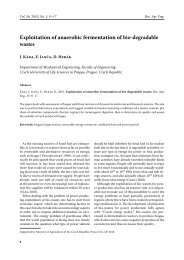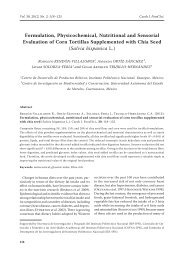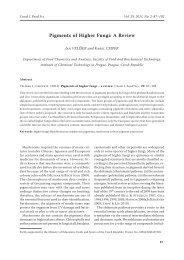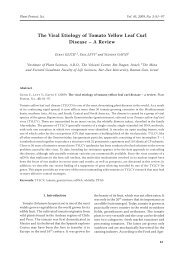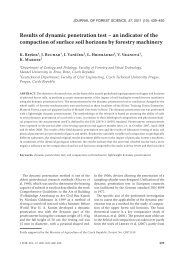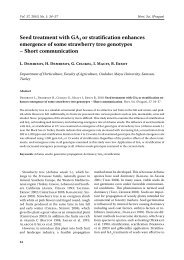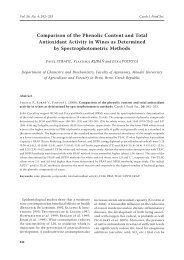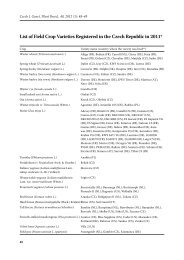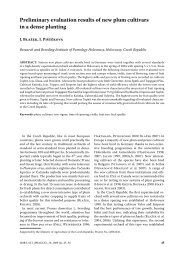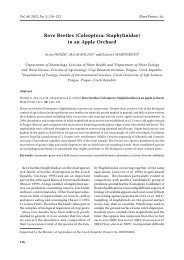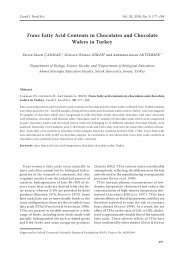Hyaluronic acid (hyaluronan): a review - Agriculturejournals.cz
Hyaluronic acid (hyaluronan): a review - Agriculturejournals.cz
Hyaluronic acid (hyaluronan): a review - Agriculturejournals.cz
Create successful ePaper yourself
Turn your PDF publications into a flip-book with our unique Google optimized e-Paper software.
Veterinarni Medicina, 53, 2008 (8): 397–411 Review Article<br />
<strong>Hyaluronic</strong> <strong>acid</strong> (<strong>hyaluronan</strong>): a <strong>review</strong><br />
J. Necas 1 , L. Bartosikova 1 , P. Brauner 2 , J. Kolar 2<br />
1 Faculty of Medicine and Dentistry, Palacky University, Olomouc, Czech Republic<br />
2 Faculty of Pharmacy, University of Veterinary and Pharmaceutical Sciences, Brno,<br />
Czech Republic<br />
ABSTRACT: <strong>Hyaluronic</strong> <strong>acid</strong> (HA) is a high molecular weight biopolysacharide, discovered in 1934, by Karl Meyer<br />
and his assistant, John Palmer in the vitreous of bovine eyes. <strong>Hyaluronic</strong> <strong>acid</strong> is a naturally occurring biopolymer,<br />
which has important biological functions in bacteria and higher animals including humans. It is found in most<br />
connective tissues and is particularly concentrated in synovial fluid, the vitreous fluid of the eye, umbilical cords<br />
and chicken combs. It is naturally synthesized by a class of integral membrane proteins called <strong>hyaluronan</strong> synthases,<br />
and degraded by a family of enzymes called hyaluronidases. This <strong>review</strong> describes metabolisms, different physiological<br />
and pathological functions, basic pharmacological properties, and the clinical use of hyaluronic <strong>acid</strong>.<br />
Keywords: hyaluronic <strong>acid</strong>; metabolism; toxicity<br />
List of abbreviations<br />
CD44 = cell surface glycoprotein; CDC37 = intracellular HA-binding protein; Da = dalton; DNA = deoxynucleotid<br />
<strong>acid</strong>; ECM = extracellular matrix; EM = electron microscopy; GHAP = glial hyaluronate-binding protein; GIT<br />
= gastrointestinal tract; HA = hyaluronic <strong>acid</strong>; HARE = hyaluronic <strong>acid</strong> receptor for endocytosis; HAS1, HAS2,<br />
and HAS3 = types of <strong>hyaluronan</strong> synthases 1, 2 and 3; IHABP = intracellular HA-binding protein; IMP = integral<br />
membrane protein; IL-1 = interleukine 1; LM = light microscopy; LYVE-1 = lymphatic vessel endocytic receptor;<br />
MRHD = maximum recommended human dose; NS = normal saline; OA = osteoarthrosis; P-32 = protein-32;<br />
RHAMM = receptor for hyaluronic <strong>acid</strong> mediated mobility; RHAMM/IHABP = receptor for hyaluronic <strong>acid</strong><br />
mediated mobility/intracellular HA-binding protein; TDLo = toxic dose low; TIMP-1 = tissue inhibitor of matrix<br />
metalloproteiness 1;TNF-α = tumor necrosis factor alpha; TSG-6 = tumor necrosis factor-α-stimulated gene-6;<br />
t 1/2 = half-life; UDP = uridine diphosphate<br />
Contents<br />
1. Introduction<br />
2. History<br />
3. Physicochemical and structural properties<br />
3.1. Chemical structure<br />
3.2. Solution structure<br />
3.3. Polymer structure<br />
3.4. Synthesis<br />
3.5. Degradation<br />
4. Mechanism of action<br />
4.1. Interactions with hyaladherins<br />
5. Pharmacokinetics<br />
5.1. Absorption rate and concentration in plasma<br />
5.2. Distribution<br />
5.3. Excretion (elimination)<br />
5.3.1. Renal excretion<br />
5.3.2. Hepatic elimination<br />
5.3.3. Pulmonary excretion<br />
5.3.4. GIT excretion<br />
6. Toxicity<br />
6.1. Cytotoxicity<br />
6.2. Neurotoxicity<br />
6.3. Carcinogenicity<br />
6.4. Mutagenicity<br />
6.5. Reproductive toxicity<br />
7. Efficacy and applications<br />
7.1. Chondroprotective effects<br />
7.2. Chondroprotective effects in vitro<br />
7.3. Chondroprotective effects in vivo<br />
397
Review Article Veterinarni Medicina, 53, 2008 (8): 397–411<br />
1. Introduction<br />
<strong>Hyaluronic</strong> <strong>acid</strong> (HA) is a carbohydrate, more specifically<br />
a mucopolysaccharide, occurring naturally<br />
in all living organisms. It can be several thousands<br />
of sugars (carbohydrates) long. When not bound to<br />
other molecules, it binds to water giving it a stiff<br />
viscous quality similar to “Jello”. The polysaccharide<br />
<strong>hyaluronan</strong> (HA) is a linear polyanion, with a<br />
poly repeating disaccharide structure [(1→3)-β-d-<br />
GlcNAc-(1→4)-β-d-GlcA-]. HA is found primarily<br />
in the extracellular matrix and pericellular matrix,<br />
but has also been shown to occur intracellularly.<br />
The biological functions of HA include maintenance<br />
of the elastoviscosity of liquid connective<br />
tissues such as joint synovial and eye vitreous fluid,<br />
control of tissue hydration and water transport,<br />
supramolecular assembly of proteoglycans in the<br />
extracellular matrix, and numerous receptor-mediated<br />
roles in cell detachment, mitosis, migration,<br />
tumor development and metastasis, and inflammation<br />
(Balazs et al., 1986; Toole et al., 2002; Turley<br />
et al., 2002; Hascall et al., 2004). Its function in the<br />
body is, amongst other things, to bind water and to<br />
lubricate movable parts of the body, such as joints<br />
and muscles. Its consistency and tissue-friendliness<br />
allows it to be used in skin-care products as an<br />
excellent moisturizer. <strong>Hyaluronic</strong> <strong>acid</strong> is one of the<br />
most hydrophilic (water-loving) molecules in nature<br />
and can be described as nature’s moisturizer.<br />
The unique viscoelastic nature of HA along with<br />
its biocompatibility and non-immunogenicity has<br />
led to its use in a number of clinical applications,<br />
including the supplementation of joint fluid in<br />
arthritis (Neo et al., 1997; Barbucci et al., 2002;<br />
Uthman et al., 2003; Medina et al., 2006), as a surgical<br />
aid in eye surgery, and to facilitate the healing<br />
and regeneration of surgical wounds. More recently,<br />
HA has been investigated as a drug delivery agent<br />
for various administration routes, including ophthalmic,<br />
nasal, pulmonary, parenteral and topical<br />
(Brown and Jones, 2005).<br />
398<br />
7.4. Orthopedic applications<br />
7.4.1. Viscosupplementation<br />
7.5. Antiadhesion applications<br />
7.6. Ophthalmology<br />
7.7. Dermatology and wound-healing applications<br />
7.8. Cardiovascular applications<br />
8. Tabular overview<br />
9. Conclusion<br />
10. References<br />
2. History<br />
In 1934, Karl Meyer and his colleague John Palmer<br />
isolated a previously unknown chemical substance<br />
from the vitreous body of cows’ eyes. They found<br />
that the substance contained two sugar molecules,<br />
one of which was uronic <strong>acid</strong>. For convenience,<br />
therfore, they proposed the name “hyaluronic <strong>acid</strong>”.<br />
The popular name is derived from “hyalos”, which is<br />
the Greek word for glass + uronic <strong>acid</strong> (Meyer and<br />
Palmer, 1934). At the time, they did not know that<br />
the substance which they had discovered would<br />
prove to be one of the most interesting and useful<br />
natural macromolecules. HA was first used commercially<br />
in 1942 when Endre Balazs applied for<br />
a patent to use it as a substitute for egg white in<br />
bakery products.<br />
The first medical application of <strong>hyaluronan</strong> for<br />
humans was as a vitreous substitution/replacement<br />
during eye surgery in the late 1950s. The used <strong>hyaluronan</strong><br />
was initially isolated from human umbilical<br />
cord, and shortly thereafter from rooster combs<br />
in a highly purified and high molecular weight form<br />
(Meyer and Palmer, 1934). The chemical structure<br />
of haluronan was essentially solved by Karl Mayer<br />
and his assocates in the 1950s. It was first isolated<br />
as an <strong>acid</strong>, but under physiological conditions it<br />
behaved like a salt (sodium hyaluronate).<br />
The term “<strong>hyaluronan</strong>” was introduced in 1986<br />
to conform with the international nomenclature of<br />
polysaccharides and is attributed to Endre Balazs<br />
(Balazs et al., 1986), who coined it to encompass<br />
the different forms the molecule can take, e.g, the<br />
<strong>acid</strong> form, hyaluronic <strong>acid</strong>, and the salts, such as<br />
sodium hyaluronate, which form at physiological<br />
pH (Laurent, 1989). HA was subsequently isolated<br />
from many other sources and the physicochemical<br />
structure properties, and biological role of this<br />
polysaccharide were studied in numerous laboratories<br />
(Kreil, 1995). This work has been summarized<br />
in a Ciba Foundation Symposium (Laurent, 1989)<br />
and a recent <strong>review</strong> (Laurent and Frazer, 1992).
Veterinarni Medicina, 53, 2008 (8): 397–411 Review Article<br />
3. Physicochemical and structural<br />
properties<br />
Hyaluronan, an extracellular matrix component,<br />
is a high molecular weight glycosaminoglycan<br />
composed of disaccharide repeats of<br />
N-acetylglucosamine and glucuronic <strong>acid</strong>. This<br />
relatively simple structure is conserved throughout<br />
all mammals, suggesting that HA is a biomolecule<br />
of considerable importance (Chen and Abatangelo,<br />
1999). In the body, HA occurs in the salt form,<br />
hyaluronate, and is found in high concentrations<br />
in several soft connective tissues, including skin,<br />
umbilical cord, synovial fluid, and vitreous humor.<br />
Significant amounts of HA are also found in lung,<br />
kidney, brain, and muscle tissues.<br />
3.1. Chemical structure<br />
The uronic <strong>acid</strong> and aminosugar in the disaccharide<br />
are d-glucuronic <strong>acid</strong> and d-N-acetylglucosamine,<br />
and are linked together through<br />
alternating beta-1,4 and beta-1,3 glycosidic bonds<br />
(see Figure 1). Both sugars are spatially related to<br />
glucose which in the beta configuration allows all<br />
of its bulky groups (the hydroxyls, the carboxylate<br />
moiety and the anomeric carbon on the adjacent<br />
sugar) to be in sterically favorable equatorial positions<br />
while all of the small hydrogen atoms occupy<br />
the less sterically favourable axial positions. Thus,<br />
the structure of the disaccharide is energetically<br />
very stable.<br />
d-Glucuronic <strong>acid</strong> N-acetylglucosamine<br />
Figure 1. Chemical structure of HA<br />
3.2. Solution structure<br />
In a physiological solution, the backbone of a<br />
<strong>hyaluronan</strong> molecule is stiffened by a combination<br />
of the chemical structure of the disaccharide,<br />
internal hydrogen bonds, and interactions<br />
with the solvent. The axial hydrogen atoms form<br />
a non-polar, relatively hydrophobic face while<br />
the equatorial side chains form a more polar, hydrophilic<br />
face, thereby creating a twisting ribbon<br />
structure. Solutions of <strong>hyaluronan</strong> manifest very<br />
unusual rheological properties and are exceedingly<br />
lubricious and very hydrophilic. In solution, the<br />
<strong>hyaluronan</strong> polymer chain takes on the form of<br />
an expanded, random coil. These chains entangle<br />
with each other at very low concentrations, which<br />
may contribute to the unusual rheological properties.<br />
At higher concentrations, solutions have an<br />
extremely high but shear-dependent viscosity. A<br />
1% solution is like jelly, but when it is put under<br />
pressure it moves easily and can be administered<br />
through a small-bore needle. It has therefore been<br />
called a “pseudo-plastic” material. The extraordinary<br />
rheological properties of <strong>hyaluronan</strong> solutions<br />
make them ideal as lubricants. There is evidence<br />
that <strong>hyaluronan</strong> separates most tissue surfaces that<br />
slide along each other. The extremely lubricious<br />
properties of <strong>hyaluronan</strong>, meanwhile, have been<br />
shown to reduce postoperative adhesion formation<br />
following abdominal and orthopedic surgery.<br />
As mentioned, the polymer in solution assumes a<br />
stiffened helical configuration, which can be attributed<br />
to hydrogen bonding between the hydroxyl<br />
groups along the chain. As a result, a coil structure<br />
is formed that traps approximately 1 000 times its<br />
weight in water (Cowman and Matsuoka, 2005).<br />
3.3. Polymer structure<br />
Hyaluronan synthase enzymes synthesize large,<br />
linear polymers of the repeating disaccharide<br />
structure of <strong>hyaluronan</strong> by alternating addition<br />
of glucuronic <strong>acid</strong> and N-acetylglucosamine to<br />
the growing chain using their activated nucleotide<br />
sugars (UDP – glucuronic <strong>acid</strong> and UDP-<br />
N-acetlyglucosamine) as substrates (Meyer and<br />
Palmer, 1934). The number of repeat disaccharides<br />
in a completed <strong>hyaluronan</strong> molecule can reach<br />
10 000 or more, a molecular mass of ~4 million<br />
daltons (each disaccharide is ~400 daltons). The<br />
average length of a disaccharide is ~1 nm. Thus,<br />
a <strong>hyaluronan</strong> molecule of 10 000 repeats could extend<br />
10 µm if stretched from end to end, a length<br />
approximately equal to the diameter of a human<br />
erythrocyte (Cowman and Matsuoka, 2005).<br />
3.4. Synthesis<br />
The cellular synthesis of HA is a unique and highly<br />
controlled process. Most glycosaminoglycans are<br />
399
Review Article Veterinarni Medicina, 53, 2008 (8): 397–411<br />
made in the cell’s Golgi networks. HA is naturally<br />
synthesized by a class of integral membrane proteins<br />
called <strong>hyaluronan</strong> synthases, of which vertebrates<br />
have three types: HAS1, HAS2, and HAS3 (Lee and<br />
Spicer, 2000). Secondary structure predictions and<br />
homology modeling indicate an integral membrane<br />
protein (IMP). An integral membrane protein is a<br />
protein molecule (or assembly of proteins) that in<br />
most cases spans the biological membrane with<br />
which it is associated (especially the plasma membrane)<br />
or which, is sufficiently embedded in the<br />
membrane to remain with it during the initial steps<br />
of biochemical purification (in contrast to peripheral<br />
membrane proteins). Hyaluronan synthase enzymes<br />
synthesize large, linear polymers of the repeating<br />
disaccharide structure of <strong>hyaluronan</strong> by alternate addition<br />
of glucuronic <strong>acid</strong> and N-acetylglucosamine<br />
to the growing chain using their activated nucleotide<br />
sugars (UDP = glucuronic <strong>acid</strong> and UDP-Nacetlyglucosamine)<br />
as substrates.<br />
3.5. Degradation<br />
In mammals, the enzymatic degradation of HA<br />
results from the action of three types of enzymes:<br />
hyaluronidase (hyase), b-d-glucuronidase, and β-Nacetyl-hexosaminidase.<br />
Throughout the body, these<br />
enzymes are found in various forms, intracellularly<br />
and in serum. In general, hyase cleaves high molecular<br />
weight HA into smaller oligosaccharides while<br />
β-d-glucuronidase and β-N-acetylhexosaminidase<br />
further degrade the oligosaccharide fragments by<br />
removing nonreducing terminal sugars (Leach and<br />
Schmidt, 2004).<br />
The degradation products of <strong>hyaluronan</strong>, oligosaccharides<br />
and very low molecular weight <strong>hyaluronan</strong>,<br />
exhibit pro-angiogenic properties (Mio<br />
and Stern, 2002). By catalyzing the hydrolysis of<br />
hyaluronic <strong>acid</strong>, a major constituent of the interstitial<br />
barrier, hyaluronidase lowers the viscosity of<br />
hyaluronic <strong>acid</strong>, thereby increasing tissue permeability.<br />
It is, therefore, used in medicine in conjunction<br />
with other drugs in order to speed their<br />
dispersion and delivery. The most common application<br />
is in ophthalmic surgery, in which it is used in<br />
combination with local anesthetics. Some bacteria,<br />
such as Staphylococcus aureus, Streptococcus pyoge-<br />
nes et pneumoniae and Clostridium perfringens,<br />
produce hyaluronidase as a means of increasing<br />
mobility through the body’s tissues and as an antigenic<br />
disguise that prevents their recognition by<br />
400<br />
phagocytes of the immune system (Ponnuraj and<br />
Jedrzejas, 2000; Lin and Stern, 2001; Lokeshwar et<br />
al., 2002; Hajjaji et al., 2005; Kim et al., 2005; Girish<br />
and Kemparaju, 2006).<br />
4. Mechanism of action<br />
Although the predominant mechanism of HA<br />
is unknown, in vivo, in vitro, and clinical studies<br />
demonstrate various physiological effects of exogenous<br />
HA.<br />
<strong>Hyaluronic</strong> <strong>acid</strong> possesses a number of protective<br />
physiochemical functions that may provide some<br />
additional chondroprotective effects in vivo and<br />
may explain its longer term effects on articular cartilage.<br />
<strong>Hyaluronic</strong> <strong>acid</strong> can reduce nerve impulses<br />
and nerve sensitivity associated with pain. In experimental<br />
osteoarthritis, this glycosaminoglycan<br />
has protective effects on cartilage (Akmal et al.,<br />
2005); exogenous hyaluronic <strong>acid</strong> is known to be<br />
incorporated into cartilage (Antonas et al., 1973).<br />
Exogenous HA enhances chondrocyte HA and<br />
proteoglycan synthesis, reduces the production and<br />
activity of proinflammatory mediators and matrix<br />
metalloproteinases, and alters the behavior of immune<br />
cells. These functions are manifested in the<br />
scavenging of reactive oxygen-derived free radicals,<br />
the inhibition of immune complex adherence to<br />
polymorphonuclear cells, the inhibition of leukocyte<br />
and macrophage migration and aggregation<br />
(Balazs and Denlinger, 1984) and the regulation of<br />
fibroblast proliferation. Many of the physiological<br />
effects of exogenous HA may be functions of its<br />
molecular weight (Noble, 2002; Uthman et al, 2003;<br />
Hascall et al., 2004; Medina et al., 2006).<br />
Hyaluronan is highly hygroscopic and this property<br />
is believed to be important for modulating<br />
tissue hydration and osmotic balance (Dechert<br />
et al., 2006). In addition to its function as a passive<br />
structural molecule, <strong>hyaluronan</strong> also acts as a<br />
signaling molecule by interacting with cell surface<br />
receptors and regulating cell proliferation, migration,<br />
and differentiation. Hyaluronan is essential<br />
for embryogenesis and is likely also important in<br />
tumorigenesis (Kosaki et al., 1999; Camenisch et<br />
al., 2000).<br />
Hyaluronan functions are diverse. Because of its<br />
hygroscopic properties, <strong>hyaluronan</strong> significantly<br />
influences hydration and the physical properties of<br />
the extracellular matrix. Hyaluronan is also capable<br />
of interacting with a number of receptors resulting
Veterinarni Medicina, 53, 2008 (8): 397–411 Review Article<br />
in the activation of signaling cascades that influence<br />
cell migration, proliferation, and gene expression<br />
(Turley et al., 2002; Taylor et al., 2004).<br />
4.1. Interactions with hyaladherins<br />
HA plays several important organizational roles<br />
in the extracellular matrix (ECM) by binding with<br />
cells and other components through specific and<br />
nonspecific interactions. Hyaluronan-binding proteins<br />
are constituents of the extracellular matrix,<br />
and stabilize its integrity. Hyaluronan receptors are<br />
involved in cellular signal transduction; one receptor<br />
family includes the binding proteins aggrecan,<br />
link protein, versican and neurocan and the receptors<br />
CD44, TSG6 (Kahmann et al., 2000), GHAP<br />
(Liu et al., 2001), and LYVE-1 (Banerji et al., 1999).<br />
The RHAMM receptor is an unrelated <strong>hyaluronan</strong>binding<br />
protein, and the <strong>hyaluronan</strong> binding sites<br />
contain a motif of a minimal site of interaction with<br />
<strong>hyaluronan</strong>. This is represented by B(X7) B, where<br />
B is any basic amino <strong>acid</strong> except histidine, and X is<br />
at least one basic amino <strong>acid</strong> and any other moiety<br />
except <strong>acid</strong>ic residues. CD44 and RHAMM have<br />
attracted much attention, because they are believed<br />
to be involved in metastasis (Toole, 1997; Ahrens<br />
et al., 2001; Noble, 2002; Toole et al., 2002).<br />
CD44 is a structurally variable and multifunctional<br />
cell surface glycoprotein expressed on most<br />
cell types (Karjalainen et al., 2000). To date, it is<br />
the best characterized transmembrane <strong>hyaluronan</strong><br />
receptor and because of its wide distribution<br />
Table 1. Normal values of kinetic parameters of HA in animals<br />
Species Compartment* t ½ (min) Extraction<br />
ratio (%)<br />
Pig<br />
Plasma clearance<br />
(mg/day)<br />
is considered to be the major <strong>hyaluronan</strong> receptor<br />
on most cell types (Tzircotis et al., 2005). Many<br />
functions of CD44 are mediated through interaction<br />
with its ligand <strong>hyaluronan</strong>, a ubiquitous extracellular<br />
polysaccharide (Toole, 1997). Hyaluronan<br />
is abundant in soft connective tissues, but also in<br />
epithelial and neural tissues.<br />
Low and intermediate molecular weight HA (2 ×<br />
10 4 –4.5 × 10 5 Da) stimulates gene expression in macrophages,<br />
endothelial cells, eosinophils and certain<br />
epithelial cells (McKee et al., 1996; Oertli et al.,<br />
1998). Hyaluronan degradation products are purported<br />
to contribute to scar formation. Fetal wounds<br />
heal without scar formation and wound fluid HA is<br />
of high molecular weight. When hyaluronidase is<br />
added to generate HA fragments, there is increased<br />
scar formation. These data support the theory that<br />
high molecular weight HA promotes cell quiescence<br />
and supports tissue integrity, whereas generation of<br />
HA breakdown products is a signal that injury has<br />
occurred and initiates an inflammatory response<br />
(Chen and Abatangelo, 1999).<br />
The role of CD44 in HA-binding and signaling has<br />
recently been investigated in hematopoietic cells<br />
from CD44-deficient mice (Schmits et al., 1997;<br />
Protin et al., 1999). CD44-deficient mice develop<br />
normally and exhibit minor abnormalities in hematopoiesis<br />
and lymphocyte recirculation (Schmits<br />
et al., 1997; Protin et al., 1999). The induction of<br />
inflammatory gene expression in response to <strong>hyaluronan</strong><br />
was observed in the absence of CD44 in<br />
bone marrow cultures and dendritic cells. These<br />
data suggest that there are CD44-independent<br />
Total daily turnover<br />
(mg/day)<br />
K m<br />
(μg/l)<br />
V max<br />
(μg/min)<br />
Method**<br />
hepatic 50 332 71 3<br />
splanchnic 23 150 24.3 3<br />
renal 14 41 8.9 3<br />
urine 11 2.9 3<br />
Sheep plasma 2–7 50 215 37 120 88 2<br />
Rabbit plasma 2–5 20–50 100 1<br />
Rat plasma 1.4 1<br />
*compartment over which the parameter was determined; t 1/2 = half-life of <strong>hyaluronan</strong>; K m = the Michaelis-Menten constant;<br />
V max = the maximum metabolic rate<br />
**method used for determination of kinetic parameters: 1 = bolus dose of labeled HA; 2 = infusion of unlabelled HA and<br />
kinetic modeling; 3 = direct measurement of HA concentration over eliminating organ<br />
401
Review Article Veterinarni Medicina, 53, 2008 (8): 397–411<br />
mechanisms for the induction of gene expression<br />
by HA (Noble, 2002).<br />
RHAMM (Receptor for HA-Mediated Mobility), has<br />
been found on cell surfaces, as well as in the cytosol<br />
402<br />
and nucleus (Leach and Schmidt, 2004). It has been<br />
implicated in regulating cellular responses to growth<br />
factors and plays a role in cell migration, particularly<br />
for fibroblasts and smooth cells (Toole, 1997).<br />
Table 2. Concentration and turnover of HA in different tissues (values within parentheses represent total amount<br />
recovered in the cavity, or injected)<br />
Tissue and species<br />
Vitreous body<br />
man 100–400<br />
Concentration of HA in<br />
tissue (μg/ml) injectate (mg/ml)<br />
t 1/2 (days)<br />
rhesus monkey 100–180 10 10–20<br />
owl monkey 300–900 10 20–30<br />
rabbit 14–52 0.02 70<br />
Anterion chamber<br />
man 1.1<br />
owl monkey 11.4 10 0.2–0.6<br />
cynomolgus 10 0.8<br />
rabbit 1.1 10 0.3–0.5<br />
rabbit 1.1 0.02 0.04–0.06<br />
Joints<br />
horse 300–500 10 1<br />
rabbit (134) 0.3 0.5<br />
rabbit 3 800 20 0.5<br />
Pleura<br />
rabbit (0.76) (0.03–0.05) 0.4–1.0<br />
Pericard<br />
rabbit 5 10 3–4<br />
rabbit 5 0.06 3–4<br />
Peritoneum<br />
rabbit (2–93) 10 1.2<br />
rabbit 0.07 0.1<br />
Skeletal muscle<br />
rabbit 26–28* 10 1.25<br />
Amniotic fluid<br />
sheep 12 week 5.1 tracer 3–8<br />
sheep 15–17 week 1.9 tracer 0.5–0.8<br />
Skin<br />
rabbit 1.9– .7<br />
rat 840* 2.6–4.5<br />
rabbit 0.07 0.5<br />
rabbit 10 2<br />
*μg/g
Veterinarni Medicina, 53, 2008 (8): 397–411 Review Article<br />
5. Pharmacokinetics<br />
The normal systemic kinetics of HA is well established<br />
in several species including man. The removal<br />
of HA from the circulation is very efficient, with a<br />
half-life of 2–6 min and a total normal turnover of<br />
10–100 mg/day in the adult human (Table 1 and 2).<br />
The main uptake from the blood takes place in the<br />
liver endothelial cells. However, evidence for a role of<br />
the kidney in the elimination of HA is accumulating.<br />
Recently published data suggest that the elimination<br />
kinetics of HA from the systemic circulation may be<br />
influenced by a number of factors, such as saturation<br />
of the elimination caused by an increased lymphatic<br />
input of HA to the circulation, alteration of the blood<br />
flow over the eliminating organ and competition with<br />
other macromolecular substances such as chondroitin<br />
sulphate or proteoglycans. Many of these factors<br />
may be operative during different disease states, and<br />
may therefore partly explain the observed differences<br />
between normal and pathological HA kinetics. The<br />
normal and pathological turnover of <strong>hyaluronan</strong> from<br />
the circulation has been determined in many different<br />
species, including man by many different authors<br />
using different techniques (Table 3).<br />
5.1. Absorption rate and concentration<br />
in plasma<br />
After i.v. injection of a bolus dose of [ 14 C]-HA in<br />
rabbits, it was shown that 98% of the administered<br />
dose had disappeared from the systemic circulation<br />
within 6 h after the administration (Lebel, 1991).<br />
Similar results were also obtained in man, where<br />
55% and 85% of the acetyl content after i.v. injection<br />
of [ 3 H]HA, was completely oxidized after 3 h and<br />
24 h, respectively (Laurent and Fraser, 1992).<br />
It is known that the major part of the elimination<br />
of HA from the blood circulation takes place in<br />
Table 3. Kinetics parameters of <strong>hyaluronan</strong> in man and animals during different disease states (Lebel, 1991)<br />
Species<br />
Man<br />
Disease<br />
Compartment*<br />
t ½<br />
(min)<br />
Extraction<br />
ratio (%)<br />
Plasma<br />
clearance<br />
(mg/day)<br />
Total daily<br />
turnover<br />
(mg/day)<br />
Method***<br />
primary bililary cirrh. plasma 6–72 50–510** 69–115 1<br />
rheumatoid arthritis plasma 2–3 970–2 060* 33–167 1<br />
kidney disease<br />
alcoholic cirrhosis<br />
splanchnic 33<br />
renal 22<br />
splanchnic 14 61.9<br />
renal 5<br />
non-cirrhotic alcoholic splanchnic 36 8.9 3<br />
liver disease renal 5 3<br />
rheumatoid arthritis urine 0.5 3<br />
primary bililary cirrhosis urine 0.9 3<br />
Werner’s sy urine 3.3 3<br />
Pig fecal peritonitis hepatic 36 84 65 3<br />
Sheep<br />
endotoxin infusion plasma 7–19 1<br />
TNF-alpha infusion plasma 3–10 1<br />
Rat experimental arthritis plasma 1–2 1<br />
*compartment over which the parameter was determined; t ½ = half-life of <strong>hyaluronan</strong><br />
**blood clearance<br />
***method used for determination of kinetic parameters: 1 = bolus dose of labeled HA; 3 = direct measurement of HA<br />
concentration over eliminating organ<br />
3<br />
3<br />
403
Review Article Veterinarni Medicina, 53, 2008 (8): 397–411<br />
the liver (Fraser et al., 1981) via receptor-mediated<br />
endocytosis in the sinusoidal liver endothelial cells<br />
(Bentsen et al., 1989; Smedsrod, 1991).<br />
5.2. Distribution<br />
HA is widely distributed in body tissues and intracellular<br />
fluids, including the aqueous and vitreous<br />
humour, and synovial fluid; it is a component of<br />
the ground substance or tissue cement surrounding<br />
cells (Laurent and Reed, 1991; Toole, 1997). It is not<br />
known whether hyaluronate sodium is distributed<br />
into breast milk.<br />
5.3. Excretion (elimination)<br />
5.3.1. Renal excretion<br />
By direct measurement of HA in urine it can be<br />
calculated that approximately 1% of the normal<br />
daily turnover of HA from the systemic circulation<br />
in man is filtered via the kidneys. Similar results<br />
were obtained in studies on man (Lebel, 1991) and<br />
in a study on rabbits (Fraser et al., 1981).<br />
Recently, the extraction ratio and clearance over<br />
the kidney in pig were reported to be 14% and 41 ml<br />
per min, using the method of measuring directly<br />
over the organ. In this study, it was also determined<br />
that the renal clearance was approximately three<br />
times the urinary clearance (Bentsen et al., 1989).<br />
5.3.2. Hepatic elimination<br />
Direct measurement of the difference of the endogenous<br />
concentration over a specific organ and<br />
knowledge of the blood flow enables calculation<br />
of the extraction ratio or clearance directly over a<br />
specific organ.<br />
By use of this method Bentsen et al. (1989) determined<br />
the hepatosplanchnic extraction ratio and<br />
clearance of <strong>hyaluronan</strong> in man to be 33% and 250<br />
ml/min, respectively.<br />
The hepatic extraction ratio and clearance have also<br />
been determined in pigs by measurement directly over<br />
the organ and were found to be 23% and 150 ml/min,<br />
respectively (Bentsen et al., 1989). In a similar study<br />
on pigs, using the same method of direct determination,<br />
the extraction ratio and clearance over the liver<br />
were determined to be 49% and 332 ml/min, respec-<br />
404<br />
tively. The reason for the discrepancies between these<br />
two studies is not known (Lebel, 1991).<br />
5.3.3. Pulmonary excretion<br />
Within 100 h, 63% and 20% of the administered<br />
dose was excreted and recovered in the respiratory<br />
gas (as 14 CO 2 ) (Lebel, 1991).<br />
5.3.4. GIT excretion<br />
The total amount of excretion into bile within<br />
24 h was reported to be very low, 0.7% of the administered<br />
dose. Similarly, the total amount of excretion<br />
into feces, within 100 h of administration,<br />
was also very small, about 0.5% of the administered<br />
dose (Lebel, 1991).<br />
6. Toxicity<br />
6.1. Cytotoxicity<br />
Jansen et al. (2004) investigated the possible cytotoxic<br />
effects, biocompatibility and degradation of a<br />
<strong>hyaluronan</strong>-based conduit for peripheral nerve repair.<br />
The results show that a <strong>hyaluronan</strong>-based conduit is<br />
not cytotoxic and shows good biocompatibility.<br />
Hyaluronan is highly non-antigenic and nonimmunogenic,<br />
owing to its high structural homology<br />
across species, and poor interaction with blood<br />
components (Amarnath et al., 2006).<br />
6.2. Neurotoxicity<br />
Because HA has an anti-inflammatory effect and<br />
prevents and/or reduces tissue adhesion, it was<br />
believed that HA epidurally-administered during<br />
epidural adhesiolysis procedures could alleviate<br />
the condition of patients with chronic lower back<br />
pain. For this reason, the following clinical trial<br />
evaluation of epidurally-administered HA neurotoxicity<br />
was performed by light microscopy (LM)<br />
and electron microscopy (EM) in rabbits. Twenty<br />
rabbits were randomly divided into two groups, a<br />
normal saline (NS) group (n = 10) and a HA group<br />
(n = 10). Saline (0.2 ml/kg of 0.9% solution) and the<br />
same volume of HA were injected into the epidural<br />
space. No rabbits showed any sensory-motor or
Veterinarni Medicina, 53, 2008 (8): 397–411 Review Article<br />
behavioural changes during the three-week period,<br />
except for one rabbit in the NS group that showed<br />
decreased appetite and activity, and weight loss.<br />
By LM, abnormal findings were observed in two<br />
rabbits in the NS group; these were thought to be<br />
the result of trauma and infection associated with<br />
epidural catheterization. EM findings showed no<br />
significant neurotoxic findings in either group. In<br />
conclusion, epidurally-administered HA did not<br />
cause neurotoxicity in rabbits (Lim et al., 2003).<br />
6.3. Carcinogenicity<br />
HA is responsible for various functions within<br />
the extracellular matrix such as cell growth, differentiation,<br />
and migration (Jara<strong>cz</strong> et al., 2005; Paiva<br />
et al., 2005). A wide range of activities can be explained<br />
by a large number of Ha-binding receptors<br />
such as cell surface glycoprotein CD44, the receptor<br />
for hyaluronic <strong>acid</strong>-mediated motility (RHAMM),<br />
and several other receptors possessing Ha-binding<br />
motifs, for example: transmembrane protein layilin,<br />
hyaluronic <strong>acid</strong> receptor for endocytosis (HARE),<br />
lymphatic vessel endocytic receptor (LYVE-1),<br />
and also intracellular HA-binding proteins including<br />
CDC37, RHAMM/IHABP, P-32, and IHABP4<br />
(Underhill, 1992; Forsberg et al., 1994; Pohl et al.,<br />
2000; Pure and Cuff, 2001; Toole, 2001; Weigel et al.,<br />
2002; Hascall et al., 2004; Hajjaji et al., 2005; Nawrat<br />
et al., 2005; Hill et al., 2006; Iacob and Knudson,<br />
2006). It has been shown that the HA level is elevated<br />
in various cancer cells (Lin and Stern, 2001) and it is<br />
believed to form a less dense matrix, thus enhancing<br />
the cell’s motililty as well as invasive ability into<br />
other tissues (Hill et al., 2006).<br />
It is well known that various tumors (epithelial,<br />
ovarial, colon, stomach and acute leukemia) overexpress<br />
HA-binding receptors CD44 and RHAMM.<br />
Consequently, these tumor cells are characterised<br />
by enhanced binding and internalization of HA.<br />
CD44-Ha interactions play various important<br />
physiological roles, including mediation or promotion<br />
of macrophage aggregation, cell migration,<br />
chondrocyte pericellular matrix assembly, and leukocyte<br />
activation.<br />
Paradoxically, both HA and the enzymes that eliminate<br />
HA, hyaluronidases, can correlate with cancer<br />
progression. It has been shown that the over expression<br />
of hyaluronic <strong>acid</strong> synthases increases the HA<br />
level, which leads to the acceleration of tumor growth<br />
and metastasis. On the other hand, exogenous oligo-<br />
metric HA inhibits tumor progression, most likely by<br />
competing with endogenous polymeric HA.<br />
6.4. Mutagenicity<br />
Sister Chromatid Exchange Assay. Under the<br />
conditions of the assay, the sodium hyaluronate<br />
Orthovisc ® solution (High Molecular Weight<br />
Hyaluronan) was not considered mutagenic to<br />
Chinese Hamster Ovary cells (Product information<br />
Orthovisc ® , 2004).<br />
Chromosomal Aberration Assay. Under the conditions<br />
of the assay, the Orthovisc ® solution was not<br />
considered mutagenic to Chinese Hamster Ovary<br />
cells (Product information Orthovisc ® , 2004).<br />
Ames Salmonella/Mammalian Microsome<br />
Mutagenicity Assay. Under the conditions of the<br />
assay, the Orthovisc ® solution was not considered<br />
mutagenic to Salmonella typhimurium tester<br />
strains (Product information Orthovisc ® , 2004).<br />
6.5. Reproductive toxicity<br />
No evidence of impairment of fertility was seen<br />
in rats and rabbits given hyaluronate sodium in<br />
doses of up to 1.43 mg per kg of body weight, approximately<br />
11 times the maximum recommended<br />
human dose (MRHD), per treatment cycle.<br />
Reproductive toxicity studies, including multigenerational<br />
studies, have been performed in rats<br />
and rabbits at doses of up to 11 times the anticipated<br />
human dose (1.43 mg/kg per treatment cycle) and<br />
have revealed no evidence of impaired fertility or<br />
harm to the experimental animal foetus caused by<br />
intra-articular injections of hyaluronate sodium.<br />
7. Efficacy and applications<br />
7.1. Chondroprotective effects<br />
The physical properties of HA are important but<br />
there is evidence to suggest that HA may provide<br />
both physiochemical and pharmacological advantages.<br />
Chondrocytes express the glykoprotein<br />
CD44 on their cell surface. This has the capacity to<br />
function as a HA receptor and so may be involved<br />
in biochemical interactions with chondrocytes. The<br />
effect of a HA injection may be mediated via CD44<br />
inteactions (Akmal et al., 2005).<br />
405
Review Article Veterinarni Medicina, 53, 2008 (8): 397–411<br />
7.2. Chondroprotective effects in vitro<br />
The chondroprotective effects of hyaluronic <strong>acid</strong>,<br />
e.g., that it stimulates the production of tissue inhibitors<br />
of matrix metalloproteineses (TIMP-1) by<br />
chondrocytes, inhibits neutrophil-mediated cartilage<br />
degradation and attenuates IL-1 induced matrix degeneration<br />
and chondrocyte cytotoxicity have been<br />
observed in vitro (Gerwin et al., 2006). Articular<br />
chondrocytes cultured in the presence of HA have a<br />
significantly greater rate of DNA proliferation and extracellular<br />
matrix production, compared with chondrocytes<br />
cultured without HA (Akmal et al., 2005).<br />
7.3. Chondroprotective effects in vivo<br />
HA has been experimentally studied as a potential<br />
agent of therapeutic intervention in osteoarthrosis<br />
(OA). Hyaluronid <strong>acid</strong> has been applied to the<br />
therapy of experimental OA. Investigations have<br />
shown that intra-articular injection of HA reduces<br />
arthritic lesions in experimental animal models of<br />
articular cartilage injury (Balazs and Denlinger,<br />
1989; Neo et al., 1997; Kim et al., 2001; Moreland,<br />
2003; Leach and Schmidt, 2004; Ding et al., 2005;<br />
Roth et al., 2005; Echigo et al., 2006).<br />
7.4. Orthopaedic applications<br />
HA plays a vital role in the development of cartilage,<br />
the maintance of the sinovial fluid and the<br />
regeneration of tendons (Toole, 1997, 2001). High<br />
concentrations of HA have been found in the ECM<br />
of all adult joint tissues, including the sinovial fluid<br />
and the outer layer cartilage (Leach and Schmidt,<br />
2004). In part because of its viscoelastic nature and<br />
ability to form highly hydrated matrices, HA acts in<br />
the joint as a lubricant and shock absorber.<br />
The pathologic changes of synovial fluid hyaluronic<br />
<strong>acid</strong>, with its decreased molecular weight and concentration,<br />
led to the concept of viscosupplementation.<br />
7.4.1. Viscosupplementation<br />
Viscosupplementation is a novel, safe, and possibly<br />
effective form of local treatment for osteoarthritis<br />
(Uthman et al., 2003). Viscosupplementation with<br />
HA products helps to improve the physiological environment<br />
in an osteoarthritic joint by supplement-<br />
406<br />
ing the shock absorption and lubrication properties<br />
of osteoarthritic synovial fluid. The rationale for using<br />
viscosupplementation is to restore the protective<br />
viscoelasticity of synovial <strong>hyaluronan</strong>, decrease pain,<br />
and improve mobility. The immediate benefits of<br />
viscosupplementation are the relief of pain. Longerterm<br />
benefits are believed to include the return of<br />
joint mobility by the restoration of transsynovial<br />
flow and, ultimately, the metabolic and rheologic<br />
homeostasis of the joint (Wang et al., 2004).<br />
Viscosupplementation came into clinical use in<br />
Japan and Italy in 1987, in Canada in 1992, in Europe in<br />
1995, and in the United States in 1997. Two hyaluronic<br />
<strong>acid</strong> products are currently available in the United<br />
States: naturally occurring <strong>hyaluronan</strong> (Hyalgan) and<br />
synthetic hylan G-F 20 (Synvisc). Hylans are crosslinked<br />
hyaluronic <strong>acid</strong>s, which gives them a higher<br />
molecular weight and increased elastoviscous properties.<br />
The higher molecular weight of hylan may make<br />
it more efficacious than hyaluronic <strong>acid</strong> because of<br />
its enhanced elastoviscous properties and its longer<br />
persistence in the joint space (Wen, 2000).<br />
7.5. Antiadhesion applications<br />
As HA is highly hydrophilic, it is a polymer that<br />
is well suited to applications requiring minimal<br />
cellular adhesion. Postoperative adhesions, which<br />
form between adjacent tissue layers following<br />
surgery, impede wound healing and often require<br />
additional surgical procedures to be repaired successfully.<br />
Barriers made from cross-linked HA have<br />
been effectively used to prevent such adhesions from<br />
forming. Furthermore, the adhesion of bacteria to<br />
biomaterials can induce infections and constitute a<br />
great risk to the patient; with this in mind, esterified<br />
HA has also been used to prevent bacterial adhesion<br />
to dental implants, intraocular lenses, and catheters<br />
(Leach and Schmidt, 2004).<br />
7.6. Ophthalmology<br />
HA, a natural component of the vitreous humor<br />
of the eye, has found many successful applications<br />
in ophthalmologic surgery. HA is particularly useful<br />
as a spacefilling matrix in the eye; thus, intraocular<br />
injection of HA during surgery is used to maintain the<br />
shape of the anterior chamber. Furthermore, HA solutions<br />
also serve as a viscosity-enhancing component<br />
of eye drops and as an adjuvant to eye tissue repair.
Veterinarni Medicina, 53, 2008 (8): 397–411 Review Article<br />
7.7. Dermatology and wound-healing<br />
applications<br />
HA is naturally present in high concentrations<br />
in the skin and soft connective tissues. Therefore,<br />
HA is an appropriate choice for a matrix to support<br />
dermal regeneration and augmentation. For<br />
example, Prestwich and co-workers found that<br />
cross-linked HA hydrogel films accelerate the<br />
healing of full-thickness wounds, presumably<br />
by providing a highly hydrated and nonimmunogenic<br />
environment that is conducive to tissue<br />
repair. Hyaff scaffolds cultured in vitro with<br />
keratinocytes and fibroblasts have been used to<br />
create materials similar to skin, including two<br />
distinct epidermal and dermal-like tissue layers.<br />
Moreover, as a result of its ability to form<br />
hydrated, expanded matrices, HA has also been<br />
successfully used in cosmetic applications such<br />
8. Tabular overview<br />
Table 4. Data on reproductive effects of <strong>hyaluronan</strong> in animals<br />
as soft tissue augmentation (Leach and Schmidt,<br />
2004; Dechert et al., 2006).<br />
7.8. Cardiovascular applications<br />
In a manner related to its antiadhesive properties,<br />
HA has also proven to be effective for increasing<br />
the blood compatibilities of cardiovascular implants<br />
such as vascular grafts and stents. For example,<br />
biomaterial surfaces treated with cross-linked HA<br />
have been associated with reduced platelet adhesion<br />
and thrombus formation (Leach and Schmidt,<br />
2004). Furthermore, sulfated HA derivatives can act<br />
as heparin mimics (Barbucci et al., 1995); in fact,<br />
HA derivatives with higher degrees of sulfation are<br />
associated with increased abilities to prevent blood<br />
coagulation (as measured by longer times required<br />
for whole blood clotting) (Barbucci et al., 1995).<br />
Effect Route Organism Dose of TDLo (mg/kg) Duration Source/No./pp/year/<br />
T16; T31; T73 subcutaneous rat 189 multigenerations OYYAA2 29, 139, 1985<br />
T46; T86 subcutaneous rat 220 7-17D preg OYYAA2 29, 111, 1985<br />
T85 subcutaneous rat 77 7-17D preg OYYAA2 29, 111, 1985<br />
T81 subcutaneous rat 660 7-17D preg OYYAA2 29, 111, 1985<br />
T12 intraperitoneal rabbit 91 6-18D preg OYYAA2 29, 131, 1985<br />
T03 parenteral rabbit 52 91D male OYYAA2 28, 1 041, 1984<br />
T03 – prostate, seminal vesicle, Cowperr’s glands, accessory glands; T12 = ovaries, fallopian tubes; T16 = parturition; T31<br />
= extra embryonic structures; T46 = musculosceletal system; T73 = sex ratio; T81 = growth statistics; T85 = behavioral;<br />
T86 = physical; OYYAA2 = Oyo Yakuri Pharmacometrics<br />
TDLo (Toxic Dose Low): the lowest dose of a substance introduced by any route, other than inhalation, over any given<br />
period of time and reported to produce any toxic effect in humans or to produce tumorigenic or reproductive effects in<br />
animals or humans<br />
Table 5. Other multiple dose data of <strong>hyaluronan</strong> in animals<br />
Effect Route Organism Dose of TDLo (mg/kg) Duration Source/No./pp/year/<br />
U01; U05; U06 oral rat 2 275 13W-I YACHDS 27, 5 809 ,1993<br />
M16; P05; P72 intraperitoneal rat 1 680 4W-I YACHDS 13, 2 763, 1985<br />
M16 = other changes in urine composition; P05 = normocytic anemia; P72 = changes in leukocyte (WBC) count; U01 =<br />
weight loss or decreased weight gain; U05 = changes in Na + ; U06 = body temperature decrease; YACHDS = Yakuri to Chiryo,<br />
Pharmacology and Therapeutics<br />
TDLo (Toxic Dose Low): the lowest dose of a substance introduced by any route, other than inhalation, over any given<br />
period of time and reported to produce any toxic effect in humans or to produce tumorigenic or reproductive effects in<br />
animals or humans<br />
407
Review Article Veterinarni Medicina, 53, 2008 (8): 397–411<br />
Table 6. Data on the reproductive effects of <strong>hyaluronan</strong> in humans<br />
Effect Route Organism Dose of TDLo (ml/kg) Source/No./pp/year/<br />
J18; J30; Y55 intrapleural human 0.036 CEXPB9 30, 203, 2003<br />
J18 = pleural thickening; J30 = other changes; Y55 = effect on inflammation or mediation of inflammation; CEXPB9 = Clinical<br />
and Experimental Pharmacology and Physiology<br />
TDLo (Toxic Dose Low): the lowest dose of a substance introduced by any route, other than inhalation, over any given<br />
period of time and reported to produce any toxic effect in humans or to produce tumorigenic or reproductive effects in<br />
animals or humans<br />
9. Conclusion<br />
<strong>Hyaluronic</strong> <strong>acid</strong> has been used for more than<br />
20 years in many products throughout the world.<br />
Because of its biocompatibility, biodegradability,<br />
and readily modified chemical structure, HA has<br />
been extensively investigated in drug-delivery applications.<br />
A variety of commercially available<br />
preparations of HA derivatives and cross-linked<br />
HA materials have been developed for drug delivery;<br />
these materials are created in forms such as<br />
films, microspheres, liposomes, fibers, and hydrogels.<br />
Through multidisciplinary discoveries about<br />
the structure, properties, biological activity, and<br />
chemical modification of this unique polymer,<br />
HA has found success in an extraordinarily broad<br />
range of biomedical applications. Future clinical<br />
therapies of HA-derived materials critically rely<br />
on a more detailed understanding of the effects of<br />
HA molecular weight and concentration and how<br />
this biomolecule specifically interacts with cells<br />
and ECM components in the body. The increased<br />
use of these materials will require finely tuned and<br />
controllable interactions between HA and its environment.<br />
Work in these areas is underway; for<br />
example, adhesive peptide sequences have been covalently<br />
bound to HA materials. Also, environmentally<br />
responsive materials have been synthesized<br />
from HA. These materials can be created to swell<br />
or degrade in response to inflammation, electrical<br />
stimulation, and heat.<br />
10. REFERENCES<br />
Ahrens T., Assmann V., Fieber C., Termeer C.C., Herrlich<br />
P., Hofmann M., Simon J.C. (2001): CD44 is the principal<br />
mediator of hyaluronic-<strong>acid</strong>-induced melanoma<br />
cell proliferation. Journal of Investigative Dermatology,<br />
116, 93–101.<br />
408<br />
Akmal M., Singh A., Anand A., Kesani A., Aslam N.,<br />
Goodship A., Bentley G. (2005): The effects of hyaluronic<br />
<strong>acid</strong> on articular chondrocytes. Journal of<br />
Bone and Joint Surger y – British volume, 8,<br />
1143–1149.<br />
Amarnath L.P., Srinivas A., Ramamurthi A. (2006): In<br />
vitro hemocompatibility testing of UV-modified <strong>hyaluronan</strong><br />
hydrogels. Biomaterials, 27, 1416–1424.<br />
Antonas K.N., Fraser J.R.E., Muirden K.D. (1973): Distribution<br />
of biologically labelled hyaluronic <strong>acid</strong> injected<br />
into joints. Annals of Rheumatic Diseases, 32,<br />
103–111.<br />
Balazs E.A., Denlinger J.L. (1984): The role of hyaluronic<br />
<strong>acid</strong> in arthritis and its therapeutic use. In: Peyron J.G.<br />
(ed.): Osteoarthritis: Current Clinical and Fundamental<br />
Problems. Geigy, Basle Geigy. 165–174.<br />
Balazs E.A., Denlinger J.L (1989): Clinical uses of <strong>hyaluronan</strong>.<br />
Ciba Found Symposium, 143, 265–275.<br />
Balazs E.A., Laurent T.C., Jeanloz R.W. (1986): Nomenclature<br />
of hyaluronic <strong>acid</strong>. Biochemical Journal, 235, 903.<br />
Banerji S., Ni J., Wang S.X., Clasper S., Su J., Tammi R.,<br />
Jones M., Jackson D.G. (1999): LYVE-1, a new homologue<br />
of the CD44 glycoprotein, is a lymph-specific<br />
receptor for <strong>hyaluronan</strong>. The Journal of Cell Biology,<br />
4, 789–801.<br />
Barbucci R., Magnani A., Casolaro M., Marchettini N.,<br />
Rosi C., Bosco M. (1995): Modification of hyaluronic<br />
<strong>acid</strong> by insertion of sulfate groups to obtain a heparinlike<br />
molecule. Part I. Characterization and behavior<br />
in aqueous solution towards H + and Cu 2+ ions. Gazzetta<br />
Chimica Italiana, 125, 169–180.<br />
Barbucci R., Lamponi S., Borzacchiello A., Ambrosio L.,<br />
Fini M., Torricelli P., Giardino R. (2002): <strong>Hyaluronic</strong><br />
<strong>acid</strong> hydrogel in the treatment of osteoarthritis. Biomaterials,<br />
23, 4503–4513.<br />
Bentsen K.D., Henriksen J.H., Boesby S., Horstev-Petersen<br />
K., Lorenzen I. (1989): Hepatic and renal excretion<br />
of circulating type III procollagen amino-terminal<br />
propeptide and <strong>hyaluronan</strong> in pig. Journal of Hepatology,<br />
9, 177–183.
Veterinarni Medicina, 53, 2008 (8): 397–411 Review Article<br />
Brown M.B., Jones S.A. (2005): <strong>Hyaluronic</strong> <strong>acid</strong>: a unique<br />
topical vehicle for the localized delivery of drugs to<br />
the skin. Journal of European Academy of Dermatology<br />
and Venereology, 19, 308–318.<br />
Camenisch T.D., Spicer A.P., Brehm-Gibson T., Biesterfeldt<br />
J., Augustine M.L., Calabro A. Jr., Kubalak S.,<br />
Klewer S.E., McDonald J.A. (2000): Disruption of <strong>hyaluronan</strong><br />
synthase-2 abrogates normal cardiac morphogenesis<br />
and <strong>hyaluronan</strong>-mediated transformation<br />
of epithelium to mesenchyme. Journal of Clinical Investigation,<br />
106, 349–360.<br />
Chen W.Y.J., Abatangelo G. (1999): Functions of <strong>hyaluronan</strong><br />
in wound repair. Wound Repair and Regeneration,<br />
7, 79–89.<br />
Cowman M.K., Matsuoka S. (2005): Experimental approaches<br />
to <strong>hyaluronan</strong> structure. Carbohydrate Research,<br />
340, 791–809.<br />
Dechert T.A., Ducale A.E., Ward S.I., Yager D.R. (2006):<br />
Hyaluronan in human acute and chronic dermal<br />
wounds. Wound Repair and Regeneration, 14,<br />
252–258.<br />
Ding M., Danielsen C.C., Hvid I. (2005): Effects of <strong>hyaluronan</strong><br />
on three-dimensional microarchitecture of<br />
subchondral bone tissues in guinea pig primary osteoarthrosis.<br />
Bone, 36, 489–501.<br />
Echigo R., Mochizuki M., Nishimura R., Sasaki N. (2006):<br />
Suppressive effect of <strong>hyaluronan</strong> on chondrocyte apoptosis<br />
in experiment induced acute osteoarthritis in<br />
dog. Journal of Veterinary Medical Sciences, 68,<br />
899–902.<br />
Forsberg N., Von Malmborg N., Madsen K., Rolfsen W.,<br />
Gustafson S. (1994): Receptors for <strong>hyaluronan</strong> on corneal<br />
endotelial cells. Experimental Eye Research, 59,<br />
689–696.<br />
Fraser J.R.E., Laurent T.C., Pertoft H., Baxter E. (1981):<br />
Plasma clearance, tissue distribution and metabolism<br />
of hyaluronic <strong>acid</strong> injected intravenously in the rabbit.<br />
Biochemical Journal, 200, 415–424.<br />
Gerwin N., Hops C., Lucke A. (2006): Intraarticular drug<br />
delivery in osteoarthritis. Advanced Drug Delivery<br />
Reviews, 58, 226–242.<br />
Girish K.S., Kemparaju K. (2006): Inhibition of Naja naja<br />
venon hyaluronidase: Role in the management of poisonous<br />
bite. Life Sciences, 87, 1433–1440.<br />
Hajjaji H.E., Cole A.A., Manicourt D.H. (2005): Chondrocytes,<br />
synoviocytes and dermal fibroblasts all express<br />
PH-20, a hyaluronidase active at neutral pH.<br />
Arthritis Research and Therapy, 7, R756–R768.<br />
Hascall V.C., Majors A.K., de la Motte C.A., Evanko S.P.,<br />
Wang A., Drazba J.A., Strong S.A., Wight T.N. (2004):<br />
Intracellular <strong>hyaluronan</strong>: a new frontier for inflammation?<br />
Biochimica and Biophysica Acta, 1673, 3–12.<br />
Hill A., McFarlane S., Johnston P.G., Waugh D.J.J. (2006):<br />
The emerging role of CD44 in regulating skeletal micrometastasis.<br />
Cancer Letters, 237, 1–9.<br />
Iacob S., Knudson C.B. (2006): Hyaluronan fragments activate<br />
nitric oxide synthase and the production of nitric<br />
oxide by articular chondrocytes. The International Journal<br />
of Biochemistry and Cell Biology, 38, 123–133.<br />
Jansen K., van der Werff J.F.A., van Wachem P.B., Nicolai<br />
J.P.A., de Leij L.F.M.H., van Luyn M.J.A. (2004): A<br />
<strong>hyaluronan</strong>-based nerve guide: in vitro cytotoxicity,<br />
subcutaneous tissue reactions, and degradation in the<br />
rat. Biomaterials, 25, 483–489.<br />
Jara<strong>cz</strong> S., Chen J., Kuznetsova L.V., Ojima I. (2005): Recent<br />
advances in tumor-targeting anticancer drug<br />
conjugates. Bioorganic and Medicinal Chemistry, 13,<br />
5043–5054.<br />
Kahmann J.D., O’Brien R., Werner J.M., Heinegard D.,<br />
Ladbury J.E., Campbell I.D., Day A.J. (2000): Localization<br />
and characterization of the <strong>hyaluronan</strong>-binding<br />
site on the Link module from human TSG-6. Structure,<br />
8, 763–774.<br />
Karjalainen J.M., Tammi R.H., Tammi M.I., Eskelinen<br />
M.J., Agren U.M., Parkkinen J.J., Alhava E.M., Kosma<br />
V.M. (2000): Reduced level of CD44 and <strong>hyaluronan</strong><br />
associated with unfavorable prognosis in clinical stage<br />
I cutaneous melanoma. American Journal of Pathology,<br />
157, 957–965.<br />
Kim C.H., Lee B.J., Yoon J., Seo K.M., Lee J.W., Choi E.S.,<br />
Hong J.J., Lee Y.S., Park J.H. (2001): Therapeutic effect<br />
of hyaluronic <strong>acid</strong> on experimental osteoarthrosis of<br />
ovine temporomandibular joint. Journal of Veterinary<br />
Medical Sciences, 63, 1083–1089.<br />
Kim E., Baba D., Kimura M., Yamashita M., Kashiwabara<br />
S., Baba T. (2005): Identification of a hyaluronidase,<br />
Hyal5, involved in penetration of mouse sperm through<br />
cumulus mass. Proceedings of the National Academy<br />
of Sciences of the United States of America, 50,<br />
18028–18033.<br />
Kosaki R., Watanabe K., Yamaguchi Y. (1999): Overproduction<br />
of <strong>hyaluronan</strong> by expression of the <strong>hyaluronan</strong><br />
synthase Has2 enhances anchorage-independent growth<br />
and tumorigenicity. Cancer Research, 59, 1141–1145.<br />
Kreil G. (1995): Hyaluronidases-A group of neglected<br />
enzymes. Protein Sciences, 4, 1666–1669.<br />
Laurent T.C. (1989): The biology of <strong>hyaluronan</strong>. In: Ciba<br />
Foundation Symposium 143. John Wiley and Sons,<br />
New York. 1–298.<br />
Laurent T.C., Fraser J.R.E. (1992): Hyaluronan. FASEB<br />
Journal, 6, 2397–2404.<br />
Laurent U.B.G., Reed R.K. (1991): Turnover of <strong>hyaluronan</strong><br />
in the tissues. Advanced Drug Delivery Reviews,<br />
7, 237–256.<br />
409
Review Article Veterinarni Medicina, 53, 2008 (8): 397–411<br />
Leach J.B., Schmidt C.E. (2004): Hyaluronan. Encyclopedia<br />
of Biomaterials and Biomedical Engineering.<br />
Marcel Dekker, New York. 779–789.<br />
Lebel L. (1991): Clearance of <strong>hyaluronan</strong> from the circulation.<br />
Advanced Drug Delivery Reviews, 7, 221–235.<br />
Lee J.Y., Spicer A.P (2000): Hyaluronan: a multifunctional,<br />
megaDalton, stealth molecule. Current Opinion<br />
in Cell Biology, 12, 581–586.<br />
Lim Y.J., Sim W.S., Kim Y.Ch., Lee S.Ch., Choi Y.L.<br />
(2003): The neurotoxicity of epidural hyaluronic <strong>acid</strong><br />
in rabbits: A light and electron microscopic examination.<br />
Anesthesia and Analgesia, 97, 1716–1720.<br />
Lin G., Stern R. (2001): Plasma hyaluronidase (Hyal-1)<br />
promotes tumor cell cycling. Cancer Letters, 163,<br />
95–101.<br />
Liu N., Gao F., Han Z., Xu X., Underhill Ch.B., Zhang L.<br />
(2001): Hyaluronan synthase 3 overexpression promotes<br />
the growth of TSU prostate cancer cells. Cancer<br />
Research, 61, 5207–5214.<br />
Lokeshwar V.B., Schroeder G.L., Carey R.I., Soloway<br />
M.S., Iida N. (2002): Regulation of hyaluronidase activity<br />
by alternative mRNA splicing. Journal of Biological<br />
Chemistry, 277, 33654–33663.<br />
McKee C.M., Penno M.B., Cowman M., Burdick M.D.,<br />
Strieter R.M., Bao C., Noble P.W. (1996): Hyaluronan<br />
(HA) fragments induce chemokine gene expression in<br />
alveolar macrophages. The role of HA size and CD44.<br />
Journal of Clinical Investigation, 98, 2403–2413.<br />
Medina J.M., Thomas A., Denegar C.R. (2006): Knee osteoarthritis:<br />
Should your patient opt for hyaluronic <strong>acid</strong><br />
injection? Journal of Family Practice, 8, 667–675.<br />
Meyer K., Palmer J.W. (1934): The polysaccharide of the<br />
vitreous humor. Journal of Biology and Chemistry, 107,<br />
629–634.<br />
Mio K., Stern R. (2002): Inhibitors of the hyaluronidases.<br />
Matrix Biology, 21, 31–37.<br />
Moreland L.W. (2003): Intra-articular <strong>hyaluronan</strong> (hyaluronic<br />
<strong>acid</strong>) and hylans for the treatment of osteoarthritis:<br />
mechanisms of action. Arthritis Research and<br />
Therapy, 5, 54–67.<br />
Nawrat P., Surazynski A., Karna E., Palka J.A. (2005):<br />
The effect of hyaluronic <strong>acid</strong> on interleukin-1-induced<br />
deregulation of collagen metabolism in cultured human<br />
skin fibriblasts. Pharmacological Research, 51,<br />
473–477.<br />
Neo H., Ishimaru J.I., Kurita K., Goss A.N. (1997): The<br />
effect of hyaluronic <strong>acid</strong> on experimental temporomandibular<br />
joint osteoarthrosis in the sheep. Journal<br />
of Oral Maxillofacial Surgery, 55, 1114–1119.<br />
Noble P.W. (2002): Hyaluronan and its catabolic products<br />
in tissue injury and repair. Matrix Biology, 21,<br />
25–29.<br />
410<br />
Oertli B., Fan X., Wuthrich R.P. (1998): Characterization<br />
of CD44-mediated <strong>hyaluronan</strong> binding by renal tubular<br />
epithelial cells. Nephrology Dialysis Transplantation,<br />
13, 271–278.<br />
Paiva P., Van Damme M.P., Tellbach M., Jones R.L.,<br />
Jobling T., Salamonsen L.A. (2005): Expression patterns<br />
of <strong>hyaluronan</strong>, <strong>hyaluronan</strong> synthases and hyaluronidases<br />
indicate a role for <strong>hyaluronan</strong> in the<br />
progression of endometrial cancer. Gynecologic Oncology,<br />
98, 193–202.<br />
Pohl M., Sakurai H., Stuart R.O., Nigam S.K. (2000): Role<br />
of <strong>hyaluronan</strong> and CD44 in in vitro branching morphogenesis<br />
of ureteric bud cells. Developmental Biology,<br />
224, 312–325.<br />
Ponnuraj K., Jedrzejas M. (2000): Mechanism of <strong>hyaluronan</strong><br />
binding and degradation: Structure of Streptococcus<br />
pneumoniae hyaluronate lyase in complex with<br />
hyaluronic <strong>acid</strong> disaccharide at 1.7 Å resolution. Journal<br />
of Molecular Biology, 299, 885–895.<br />
Product information. Orthovisc ® , Summary of safety and<br />
effectiveness data. 2004, 1–15.<br />
Protin U., Schweighoffer T., Jochum W., Hilberg F. (1999):<br />
CD44-deficient mice develop normally with changes in<br />
subpopulations and recirculation of lymphocyte subsets1.<br />
The Journal of Immunology, 163, 4917–4923.<br />
Pure E., Cuff C.A. (2001): A crucial role for CD44 in<br />
inflammation. Trends in Molecular Medicine, 7,<br />
213–221.<br />
Roth A., Mollenhauer J., Wagner A., Fuhrmann R.,<br />
Straub A., Venbrocks R.A., Petrow P., Brauer R., Schubert<br />
H., Ozegowski J., Peschel G., Muller P.J. (2005):<br />
Intra-articular injections of high-molecular-weight<br />
hyaluronic <strong>acid</strong> have biphasic effects on joint inflammation<br />
and destruction in rat antigen-induced arthritis.<br />
Arthritis Research and Therapy, 7, 677–686.<br />
Schmits R., Filmus J., Gerwin N., Senaldi G., Kiefer F.,<br />
Kundig T., Wakeham A., Shahinian A., Catzavelos C.,<br />
Rak J., Furlonger C., Zakarian A., Simard J.J.L., Ohashi<br />
P.S., Paige C.J., Gutierrez-Ramos J.C., Mak T.W (1997):<br />
CD44 regulates hematopoietic progenitor distribution,<br />
granuloma formation, and tumorigenicity. Blood, 90,<br />
2217–2233.<br />
Smedsrod B. (1991): Cellular events in the uptake and<br />
degradation of <strong>hyaluronan</strong>. Advanced Drug Delivery<br />
Reviews, 7, 265–278.<br />
Taylor K.R., Trowbridge J.M., Rudisill J.A., Termeer C.C.,<br />
Simon J.C., Gallo R.L. (2004): Hyaluronan fragments<br />
stimulate endothelial recognition of injury through<br />
TLR4. Journal of Biological Chemistr y, 279,<br />
17079–17084.<br />
Toole B.P. (1997): Hyaluronan in morphogenesis. Journal<br />
of Internal Medicine, 242, 35–40.
Veterinarni Medicina, 53, 2008 (8): 397–411 Review Article<br />
Toole B.P. (2001): Hyaluronan in morphogenesis. Cell<br />
and Developmental Biology, 12, 79–87.<br />
Toole B.P., Wight T.N., Tammi M.I. (2002): Hyaluronancell<br />
interactions in cancer and vascular disease. Journal<br />
of Biological Chemistry, 277, 4593–4596.<br />
Turley E.A., Noble P.W., W. Bourguignon L.Y. (2002):<br />
Signaling properties of <strong>hyaluronan</strong> receptors. Journal<br />
of Biological Chemistry, 277, 4589–4592.<br />
Tzircotis G., Thorne R.F., Isacke C.M. (2005): Chemotaxis<br />
towards <strong>hyaluronan</strong> is dependent on CD44 expression<br />
and modulated by cell type variation in<br />
CD44-<strong>hyaluronan</strong> binding. Journal of Cell Science,<br />
118, 5119–5128.<br />
Underhill C. (1992): CD44: The <strong>hyaluronan</strong> receptor.<br />
Journal of Cell Sciences, 103, 293–298.<br />
Corresponding Author:<br />
Uthman I., Raynauld J.P., Haraoui B. (2003): Intra-articular<br />
therapy in osteoarthritis. Postgradual Medicine<br />
Journal, 79, 449–453.<br />
Wang C.T., Lin J., Chang C.J., Lin Y.T., Hon S.M. (2004):<br />
Therapeutics effects of hyaluronic <strong>acid</strong> on osteoarthritis<br />
of the knee. The Journal of Bone and Joint Surgery<br />
– American Volume, 3, 538–545.<br />
Weigel J.A., Raymond R.C., Weigel P.H. (2002): The <strong>hyaluronan</strong><br />
receptor for endicytosis (HARE) is not CD44<br />
or CD54 (ICAM-1). Biochemical and Biophysical Research<br />
Communications, 294, 918–922.<br />
Wen D.Y. (2000): Intra-articular hyaluronic <strong>acid</strong> injections<br />
for knee osteoarthrosis. American Family Physician,<br />
62, 565–570.<br />
Received: 2008–01–02<br />
Accepted after corrections: 2008–08–12<br />
Doc. MUDr. Jiri Necas, PhD., Palacky University Olomouc, Faculty of Medicine and Dentistry, Department<br />
of Physiology, Hnevotinska 3, 775 15 Olomouc, Czech Republic<br />
Tel. +420 585 632 351, fax +420 585 632 368, e-mail: sacenj@seznam.<strong>cz</strong><br />
411




